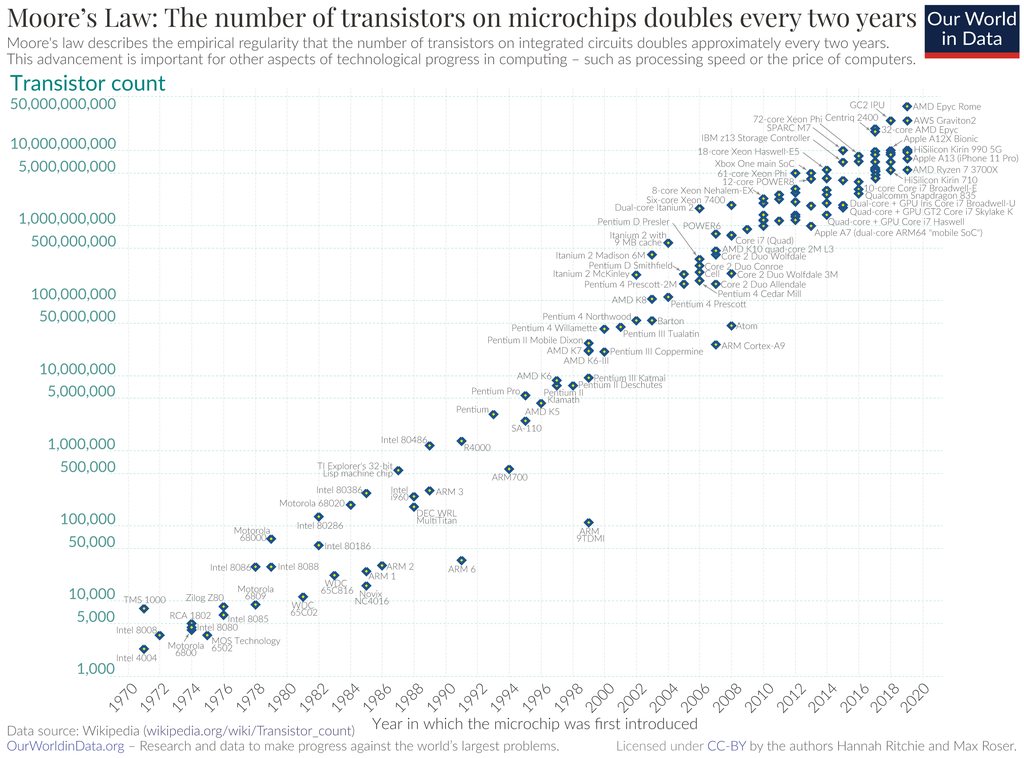Moore's Law¶
Moore's Law was formulated in 1965 by Gordon Moore, co-founder of Intel, and states that every 2 years the number of transistors in a microprocessor.
Thanks to this tendency to increase the number of transistors, the power and calculation capacity have increased exponentially from the year 1965 to the present. It is expected that it will continue to increase for a few more years, until the technology runs into quantum effects, which will not allow us to continue making smaller transistors.
This law is also valid for other transistor-based devices such as RAM or Flash memory.

Max Roser, Hannah Ritchie, CC BY-SA 4.0, vía Wikimedia Commons.¶
Capacity/price ratio¶
Computer hardware devices experience severe price deflation over time, causing a very expensive, top-of-the-line device to become an obsolete device in the cheaper price range in a few years.
A good guideline when buying hardware is not to buy the cheapest on the market, since it usually has a low capacity/price ratio.
On the other hand, the newest devices on the market are usually launched with very high prices because they are products with the highest capacity or performance and that makes them more attractive. The result is that these high-end devices often have a poor capability/price or performance/price ratio as well.
These concepts are reflected in the tables below.
SanDisk brand USB flash drive price table on Amazon in 2022.
| Capacity [Gbytes] | Price [€] | Capacity/price [Gbyte/€] |
|---|---|---|
| 16 | 6 | 2.67 |
| 32 | 8 | 4.00 |
| 64 | 10 | 6.40 |
| 128 | 17.70 | 7.23 |
| 256 | 30.90 | 8.28 |
| 512 | 87.80 | 5.83 |
As can be seen, the lowest priced devices can be upgraded by doubling their capacity for a little more money.
The price-per-Gigabyte ratio is constantly improving until we get to the newest, highest-end device, which is priced so much higher than the rest during the launch period, so it's not worth buying for its lower capacity/price ratio .
Table of prices of Intel processors in Amazon in 2022. The computation capacity has been obtained from the page of PassMark Software.
| Model | Performance [PC Mark] | Price [€] | Performance/price |
|---|---|---|---|
| i5-3470 3.2GHz | 4666 | 65.82 | 71 |
| i5-11400F 2.6GHz | 17191 | 150.45 | 114 |
| i5-12400 2.5GHz | 19500 | 200.00 | 98 |
| i5-12600KF | 27052 | 270.00 | 100 |
| i9-12900KS 2.4GHz | 44482 | 795.00 | 56 |
Lower performance processor models are not sold as stand-alone processors, but are still sold in pre-built computers, despite being outdated and having a poor performance/price ratio.
We can see again that the cheapest equipment has a poor performance/price ratio, just like the more expensive and high-end ones. The best purchase is in an intermediate team, with the best performance/price ratio.